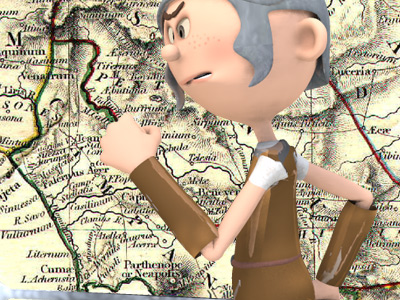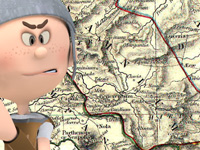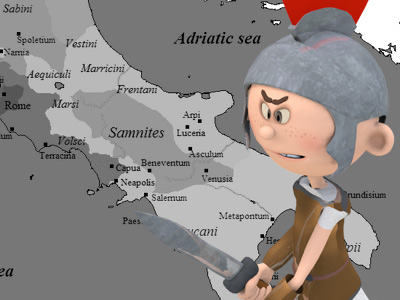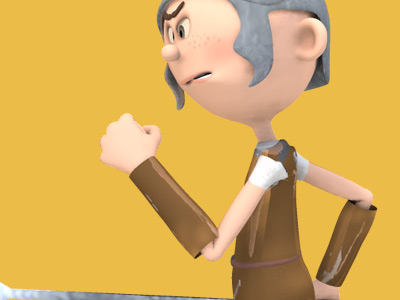Third Samnite War (298-290 BC)

296 BC Etruscan Intervention
The consuls for 296 BC were Appius Claudius Caecus and Lucius Volumnius Flamma Violens. The previous consuls were given a six-month extension of their command as proconsuls to carry on the war in Samnium. Publius Decius ravaged Samnium until he drove the Samnite army outside its territory. This army went to Etruria to back up previous calls for an alliance, which had been turned down, with intimidation and insisted on the Etruscan council being convened. The Samnites pointed out that they could not defeat Rome by themselves, but an army of all the Etruscans, the richest nation in Italy, backed up by the Samnite army could. Meanwhile, Publius Decius decided to switch from ravaging the countryside to attacking cities as the Samnite army was away. He seized Murgantia, a strong city, and Romulea. After that he marched to Ferentium, which was in southern Etruria. Livy pointed out some discrepancies between his sources, noting that some annalists said that Romulea and Ferentium were taken by Quintus Fabius and that Publius Decius took only Murgantia, while others said that the towns were taken by the consuls of the year, and others still gave all the credit to Lucius Volumnius who, they said, had sole command in Samnium.
Meanwhile, in Etruria Gellius Egnatius, a Samnite commander, was organising a campaign against Rome. Almost all the Etruscan city-states voted for war, the nearest Umbrian tribes joined in and there were attempts to hire Gauls as auxiliaries. News of this reached Rome and Appius Claudius set off for Etruria with two legions and 15,000 allied troops. Lucius Volumnius had already left for Samnium with two legions and 12,000 allies. This is the first time Livy gives details about the Roman The Roman Republic was a form of government of Rome and the era of the classical Roman civilization when it was run through public representation of the Roman people. Beginning with the overthrow of the Roman Kingdom (traditionally dated to 509 BC) and ending in 27 BC with the establishment of the Roman Empire, Rome's control rapidly expanded during this period - from the city's immediate surroundings to hegemony over the entire Mediterranean world. forces and figures for the allied troops for the Samnite wars. It is also the first time that we hear of the consuls commanding two legions each. Including the forces of the proconsuls, in this year the Romans must have mobilised six legions.
The Roman Republic was a form of government of Rome and the era of the classical Roman civilization when it was run through public representation of the Roman people. Beginning with the overthrow of the Roman Kingdom (traditionally dated to 509 BC) and ending in 27 BC with the establishment of the Roman Empire, Rome's control rapidly expanded during this period - from the city's immediate surroundings to hegemony over the entire Mediterranean world. forces and figures for the allied troops for the Samnite wars. It is also the first time that we hear of the consuls commanding two legions each. Including the forces of the proconsuls, in this year the Romans must have mobilised six legions.
Appius Claudius suffered a number of setbacks and lost the confidence of his troops. Lucius Volumnius, who had taken three fortifications in Samnium, sent Quintus Fabius to suppress disturbances by the plebeians in Lucania, left the ravaging of rural Samnium to Publius Decius and went to Etruria. Livy notes that some annalists said that Appius Claudius had written him a letter to summon him from Samnium and that this became a subject of dispute between the two consuls, with the former denying it and the latter insisting that he had been summoned by the former. Livy thought that Appius Claudius did not write the letter, but said that he wanted to send his colleague back to Samnium and felt that he ungratefully denied his need for help. However, the soldiers begged him to stay. A dispute between the two men ensued, but the soldiers insisted that both consuls fight in Etruria. The Etruscans faced Lucius Volumnius and the Samnites advanced on Appius Claudius. Livy said that "the enemy could not withstand a force so much greater than they were accustomed to meet." They were routed; 7,900 were killed and 2,010 were captured.
Lucius Volumnius hurried back to Samnium because the proconsulships of Quintus Fabius and Publius Decius were about to expire. Meanwhile, the Samnites raised new troops and raided Roman territories and allies in Campania around Capua and Falernium. Lucius Volumnius headed for Campania and was informed that the Samnites had gone back to Samnium to take their loot. He caught up with their camp and defeated a force which was made unfit to fight by the burden of their loot. The Samnite commander, Staius Minatius, was attacked by the prisoners of the Samnites and delivered to the consul. The senate decided to establish the colonies of Minturnae on the mouth of the River Liris and Sinuessa further inland, in the former territory of the Ausoni.
HISTORY

RESOURCES
This article uses material from the Wikipedia article "Samnite Wars", which is released under the Creative Commons Attribution-Share-Alike License 3.0.
© Stories Preschool. All Rights Reserved.











